Habitat Protection in Urban–Rural Fringes through Coordinated Ecological Network Construction and Territorial Planning
Abstract
1. Introduction
2. Study Area and Data Source
2.1. Study Area
2.2. Data Source
3. Methods
3.1. Delimiting the URF
3.2. Identifying Ecological Sources
3.2.1. Identification of High-Value Habitats in Six Districts
- (1)
- Habitat Quality Assessment Using the InVEST Model
- (2)
- Core Areas Extraction Using MSPA
- (3)
- High-Value Habitat Identification through Patch Connectivity Analysis
3.2.2. Identification of High-Value URF Habitats in Qingpu District
- (1)
- Core Areas Extraction Using MSPA
- (2)
- High-Value URF Habitats Identification Based on a Comprehensive Evaluation System
3.3. Designing the Resistance Surface
3.4. Constructing and Evaluating ENs
4. Results
4.1. Results of EN Construction
4.1.1. The Initial EN
4.1.2. The Optimized EN
4.2. Evaluation of the Cost-Effectiveness of ENs
5. Discussion
5.1. A Tailored Method for Identifying High-Value UFR Habitats
5.2. URF Habitat Protection through Coordinated EN Construction and Territorial Planning
5.3. Limitations and Future Research Directions
- (1)
- Indicator Selection
- (2)
- Integration into Territorial Planning
- (3)
- Species-Specific Focus
6. Conclusions
Author Contributions
Funding
Data Availability Statement
Conflicts of Interest
Appendix A

| Clustering Results | Urban | Urban–Rural Fringe | Rural |
|---|---|---|---|
| Cluster center of DN | 39.01 | 21.30 | 5.75 |
| Max DN | 158.84 | 35.94 | 17.47 |
| Min DN | 13.37 | 4.80 | 0 |
| Cluster center of DNFI | 15.12 | 22.82 | 5.64 |
| Max DNFI | 56.87 | 119.12 | 24.56 |
| Min DNFI | 2.27 | 3.80 | 0 |
| Number of Samples | 53,049 | 132,931 | 177,501 |
| Area (km2) | 527.09 | 1333.59 | 1774.13 |
| Percentage | 14.50% | 36.69% | 48.81% |


| Land Use/Land Cover | Equivalent Value per Unit Area/1012 Yuan |
|---|---|
| Forest | 2.60 |
| Bush | 1.57 |
| Grass | 1.27 |
| Paddy field | 0.21 |
| Dry land | 0.13 |
| Lake | 2.55 |
| River | 2.55 |
| Pond | 2.00 |
| Wetland | 7.87 |
| Construction Land | 0 |
| Bare Land | 0.02 |
| Source | Total Area (hm2) | Area and Percentages of Each LULC (hm2) | |||||
|---|---|---|---|---|---|---|---|
| Lake | Pond | River | Bush | Wetland | Forest | ||
| A | 8276.39 | 7125.07 (86.09%) | 927.82 (11.21%) | 87.64 (1.06%) | 0.85 (0.01%) | 2.04 (0.02%) | 133.09 (1.61%) |
| B | 956.46 | 172.67 (18.05%) | 340.71 (35.62%) | 2.8 (0.29%) | 440.27 (46.03%) | ||
| C | 306.84 | 163.43 (53.26%) | 0.21 (0.07%) | 143.2 (46.67%) | |||
| D | 1022.20 | 84.77 (8.29%) | 118.8 (11.62%) | 116.1 (11.36%) | 1.04 (0.1%) | 0.22 (0.02%) | 701.27 (68.6%) |
| E | 353.68 | 214.78 (60.73%) | 0.04 (0.01%) | 0.2 (0.06%) | 138.66 (39.2%) | ||
| F | 353.01 | 292.63 (82.9%) | 60.38 (17.1%) | ||||
| G | 676.46 | 651.01 (96.24%) | 25.45 (3.76%) | ||||
| H | 425.39 | 179.87 (42.28%) | 243.12 (57.15%) | 2.4 (0.56%) | |||
| I | 230.87 | 155.5 (67.35%) | 75.37 (32.65%) | ||||
| J | 1556.10 | 1509.61 (97.01%) | 36.24 (2.33%) | 1.39 (0.09%) | 0.09 (0.01%) | 8.77 (0.56%) | |
| K | 580.87 | 223.95 (38.55%) | 148.25 (25.52%) | 83.47 (14.37%) | 125.2 (21.55%) | ||
| L | 183.30 | 94.77 (51.34%) | 85.32 (46.22%) | 4.5 (2.44%) | |||
| M | 613.14 | 407.29 (66.15%) | 199.64 (32.42%) | 7.87 (1.28%) | 0.23 (0.04%) | 0.69 (0.11%) | |
| N | 297.51 | 249.18 (83.76%) | 48.33 (16.24%) | ||||

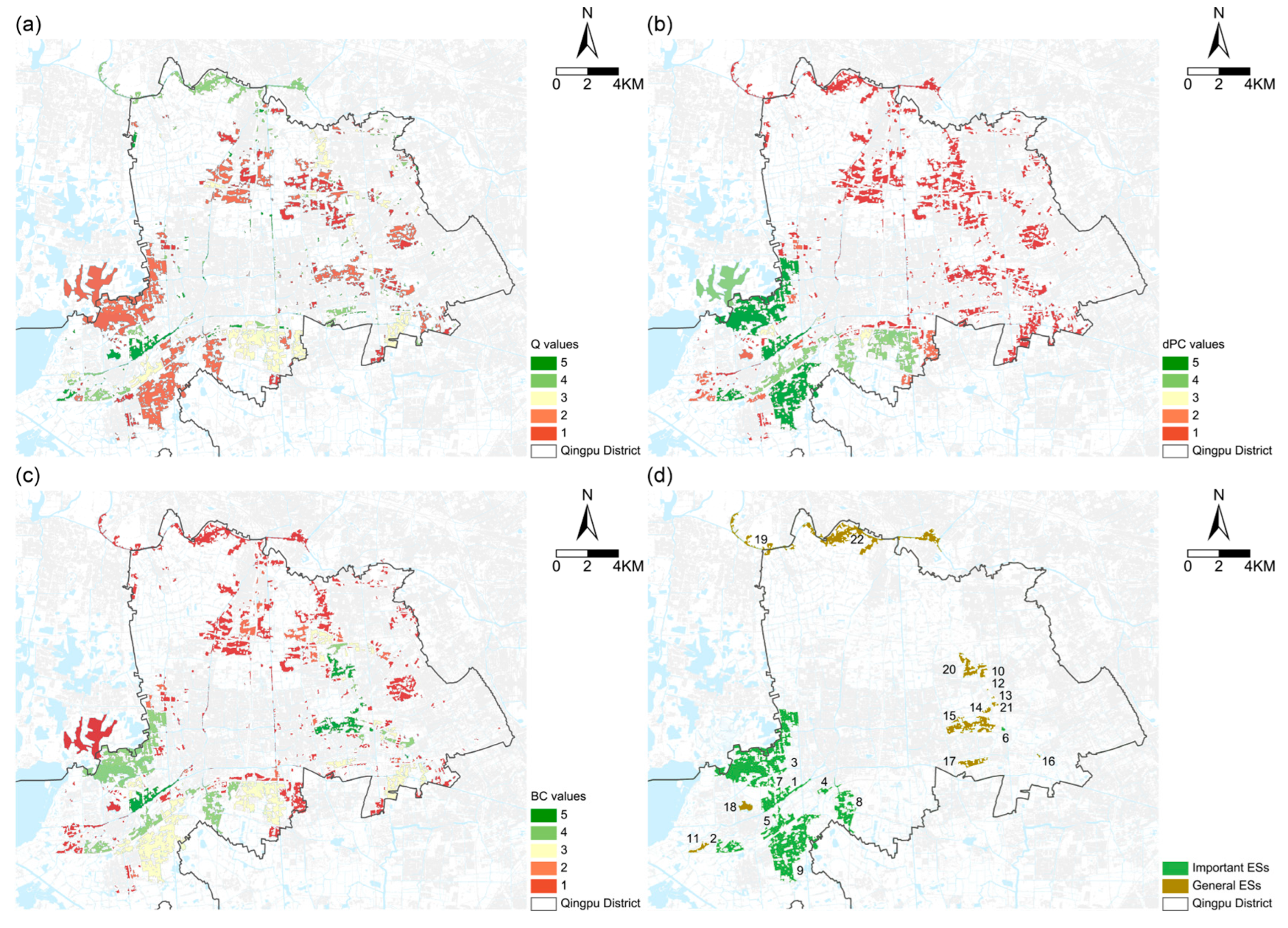
References
- Allen, A. Environmental planning and management of the peri-urban interface: Perspectives on an emerging field. Environ. Urban. 2003, 15, 135–148. [Google Scholar] [CrossRef]
- González, C. Evolution of the concept of ecological integrity and its study through networks. Ecol. Model. 2023, 476, 110224. [Google Scholar] [CrossRef]
- Li, J.; Gao, J.; Zhang, X.; Zheng, X. Effects of urbanization on biodiversity: A review. Chin. J. Ecol. 2005, 24, 953–957. [Google Scholar] [CrossRef]
- Tang, X.; Xing, Z. Research on Construction of Greenbelt Around a City Integrating Protection of Semi-natural Habitats in Urban Fringe. Landsc. Archit. 2021, 28, 90–95. [Google Scholar] [CrossRef]
- Zerbe, S.; Maurer, U.; Schmitz, S.; Sukopp, H. Biodiversity in Berlin and its potential for nature conservation. Landsc. Urban Plan. 2003, 62, 139–148. [Google Scholar] [CrossRef]
- Haregeweyn, N.; Fikadu, G.; Tsunekawa, A.; Tsubo, M.; Meshesha, D.T. The dynamics of urban expansion and its impacts on land use/land cover change and small-scale farmers living near the urban fringe: A case study of Bahir Dar, Ethiopa. Landsc. Urban Plan. 2012, 106, 149–157. [Google Scholar] [CrossRef]
- Allan, J.R.; Possingham, H.P.; Atkinson, S.C.; Waldron, A.; Di Marco, M.; Butchart, S.H.M.; Adams, V.M.; Kissling, W.D.; Worsdell, T.; Sandbrook, C.; et al. The minimum land area requiring conservation attention to safeguard biodiversity. Science 2022, 376, 1094–1101. [Google Scholar] [CrossRef] [PubMed]
- Ma, W.; Jiang, G.; Chen, Y.; Qu, Y.; Zhou, T.; Li, W. How feasible is regional integration for reconciling land use conflicts across the urban–rural interface? Evidence from Beijing–Tianjin–Hebei metropolitan region in China. Land Use Policy 2020, 92, 104433. [Google Scholar] [CrossRef]
- Wang, S.; Wu, M.; Hu, M.; Fan, C.; Wang, T.; Xia, B. Promoting landscape connectivity of highly urbanized area: An ecological network approach. Ecol. Indic. 2021, 125, 107487. [Google Scholar] [CrossRef]
- Shen, J.; Zhu, W.; Peng, Z.; Wang, Y. Improving landscape ecological network connectivity in urbanizing areas from dual dimensions of structure and function. Ecol. Model. 2023, 482, 110380. [Google Scholar] [CrossRef]
- Tang, X. The Protection Planning of Small and Micro Habitats in Urban Fringe Areas: Enlightenment from the Management of High Natural Value Farmland in the EU to the Maintenance of Biodiversity in Urban Areas in China. Urban Plan. Int. 2021, 36, 74–116. [Google Scholar] [CrossRef]
- Schmitz, M.F.; Arnaiz-Schmitz, C.; Sarmiento-Mateos, P. High Nature Value Farming Systems and Protected Areas: Conservation Opportunities or Land Abandonment? A Study Case in the Madrid Region (Spain). Land 2021, 10, 721. [Google Scholar] [CrossRef]
- Han, L.; Wang, Z.; Wei, M.; Wang, M.; Shi, H.; Ruckstuhl, K.; Yang, W.; Alves, J. Small patches play a critical role in the connectivity of the Western Tianshan landscape, Xinjiang, China. Ecol. Indic. 2022, 144, 109542. [Google Scholar] [CrossRef]
- McGarigal, K.; Cushman, S.A. Comparative Evaluation of Experimental Approaches To the Study of Habitat Fragmentation Effects. Ecol. Appl. 2002, 12, 335–345. [Google Scholar] [CrossRef]
- Saura, S.; Estreguil, C.; Mouton, C.; Rodríguez-Freire, M. Network analysis to assess landscape connectivity trends: Application to European forests (1990–2000). Ecol. Indic. 2011, 11, 407–416. [Google Scholar] [CrossRef]
- Szangolies, L.; Rohwäder, M.-S.; Jeltsch, F. Single large AND several small habitat patches: A community perspective on their importance for biodiversity. Basic Appl. Ecol. 2022, 65, 16–27. [Google Scholar] [CrossRef]
- Wang, H.; Gao, Y.; Li, Y.; Li, N.; Grueter, C.C.; Xu, H.; Huang, Z.; Cui, L.; Xiao, W. Stepping Stone Strategy: A Cost-Effective Way to Address Habitat Fragmentation of Endangered Wildlife in Montane Forest. Ecosyst. Health Sustain. 2023, 9, 0073. [Google Scholar] [CrossRef]
- Fletcher, R.J.; Didham, R.K.; Banks-Leite, C.; Barlow, J.; Ewers, R.M.; Rosindell, J.; Holt, R.D.; Gonzalez, A.; Pardini, R.; Damschen, E.I.; et al. Is habitat fragmentation good for biodiversity? Biol. Conserv. 2018, 226, 9–15. [Google Scholar] [CrossRef]
- Leroux, S.J.; Schmiegelow, F.K.A.; Lessard, R.B.; Cumming, S.G. Minimum dynamic reserves: A framework for determining reserve size in ecosystems structured by large disturbances. Biol. Conserv. 2007, 138, 464–473. [Google Scholar] [CrossRef]
- Li, F.; Ye, Y.; Song, B.; Wang, R. Evaluation of urban suitable ecological land based on the minimum cumulative resistance model: A case study from Changzhou, China. Ecol. Model. 2015, 318, 194–203. [Google Scholar] [CrossRef]
- Griffiths, M.B. Lamb Buddha’s Migrant Workers: Self-Assertion on China’s Urban Fringe. J. Curr. Chin. Aff. 2010, 39, 3–37. [Google Scholar] [CrossRef]
- Liu, X.; Li, X.; Zhang, Y.; Wang, Y.; Chen, J.; Geng, Y. Spatiotemporal evolution and relationship between construction land expansion and territorial space conflicts at the county level in Jiangsu Province. Ecol. Indic. 2023, 154, 110662. [Google Scholar] [CrossRef]
- Zhang, J.; Chen, Y.; Zhu, C.; Huang, B.; Gan, M. Identification of Potential Land-Use Conflicts between Agricultural and Ecological Space in an Ecologically Fragile Area of Southeastern China. Land 2021, 10, 1011. [Google Scholar] [CrossRef]
- Zhang, R.; Zhang, Q.; Zhang, L.; Zhong, Q.; Liu, J.; Wang, Z. Identification and extraction of a current urban ecological network in Minhang District of Shanghai based on an optimization method. Ecol. Indic. 2022, 136, 108647. [Google Scholar] [CrossRef]
- Ignatieva, M.; Stewart, G.H.; Meurk, C. Planning and design of ecological networks in urban areas. Landsc. Ecol. Eng. 2010, 7, 17–25. [Google Scholar] [CrossRef]
- Jongman, R.H.; Külvik, M.; Kristiansen, I. European ecological networks and greenways. Landsc. Urban Plan. 2004, 68, 305–319. [Google Scholar] [CrossRef]
- Huang, L.; Wang, J.; Fang, Y.; Zhai, T.; Cheng, H. An integrated approach towards spatial identification of restored and conserved priority areas of ecological network for implementation planning in metropolitan region. Sustain. Cities Soc. 2021, 69, 102865. [Google Scholar] [CrossRef]
- Xu, A.; Hu, M.; Shi, J.; Bai, Q.; Li, X. Construction and optimization of ecological network in inland river basin based on circuit theory, complex network and ecological sensitivity: A case study of Gansu section of Heihe River Basin. Ecol. Model. 2024, 488, 110578. [Google Scholar] [CrossRef]
- Zhang, R.; Zhang, L.; Zhong, Q.; Zhang, Q.; Ji, Y.; Song, P.; Wang, Q. An optimized evaluation method of an urban ecological network: The case of the Minhang District of Shanghai. Urban For. Urban Green. 2021, 62, 127158. [Google Scholar] [CrossRef]
- Aslan, C.E.; Brunson, M.W.; Sikes, B.A.; Epanchin-Niell, R.S.; Veloz, S.; Theobald, D.M.; Dickson, B.G. Coupled ecological and management connectivity across administrative boundaries in undeveloped landscapes. Ecosphere 2021, 12, e03329. [Google Scholar] [CrossRef]
- Liu, X.; Li, X.; Yang, J.; Fan, H.; Zhang, J.; Zhang, Y. How to resolve the conflicts of urban functional space in planning: A perspective of urban moderate boundary. Ecol. Indic. 2022, 144, 109495. [Google Scholar] [CrossRef]
- Liu, H.; Niu, T.; Yu, Q.; Yang, L.; Ma, J.; Qiu, S.; Wang, R.; Liu, W.; Li, J. Spatial and temporal variations in the relationship between the topological structure of eco-spatial network and biodiversity maintenance function in China. Ecol. Indic. 2022, 139, 108919. [Google Scholar] [CrossRef]
- Zhao, H.; He, J.; Liu, D.; Han, Y.; Zhou, Z.; Niu, J. Incorporating ecological connectivity into ecological functional zoning: A case study in the middle reaches of Yangtze River urban agglomeration. Ecol. Inform. 2023, 75, 102098. [Google Scholar] [CrossRef]
- Wang, Y.; Qu, Z.; Zhong, Q.; Zhang, Q.; Zhang, L.; Zhang, R.; Yi, Y.; Zhang, G.; Li, X.; Liu, J. Delimitation of ecological corridors in a highly urbanizing region based on circuit theory and MSPA. Ecol. Indic. 2022, 142, 109258. [Google Scholar] [CrossRef]
- Wei, Q.; Halike, A.; Yao, K.; Chen, L.; Balati, M. Construction and optimization of ecological security pattern in Ebinur Lake Basin based on MSPA-MCR models. Ecol. Indic. 2022, 138, 108857. [Google Scholar] [CrossRef]
- Donati, G.F.; Bolliger, J.; Psomas, A.; Maurer, M.; Bach, P.M. Reconciling cities with nature: Identifying local Blue-Green Infrastructure interventions for regional biodiversity enhancement. J. Environ. Manag. 2022, 316, 115254. [Google Scholar] [CrossRef]
- Reza, M.I.H.; Rafaai, N.H.; Abdullah, S.A. Application of graph-based indices to map and develop a connectivity importance index for large mammal conservation in a tropical region: A case study in Selangor State, Peninsular Malaysia. Ecol. Indic. 2022, 140, 109008. [Google Scholar] [CrossRef]
- Chen, H.; Yan, W.; Li, Z.; Wende, W.; Xiao, S.; Wan, S.; Li, S. Spatial patterns of associations among ecosystem services across different spatial scales in metropolitan areas: A case study of Shanghai, China. Ecol. Indic. 2022, 136, 108682. [Google Scholar] [CrossRef]
- Huang, Z.; Qian, L.; Cao, W. Developing a Novel Approach Integrating Ecosystem Services and Biodiversity for Identifying Priority Ecological Reserves. Resour. Conserv. Recycl. 2021, 179, 106128. [Google Scholar] [CrossRef]
- Yang, Y.; Feng, Z.; Wu, K.; Lin, Q. How to construct a coordinated ecological network at different levels: A case from Ningbo city, China. Ecol. Inform. 2022, 70, 101742. [Google Scholar] [CrossRef]
- Liang, C.; Zeng, J.; Zhang, R.-C.; Wang, Q.-W. Connecting urban area with rural hinterland: A stepwise ecological security network construction approach in the urban-rural fringe. Ecol. Indic. 2022, 138, 108794. [Google Scholar] [CrossRef]
- Lumia, G.; Praticò, S.; Di Fazio, S.; Cushman, S.; Modica, G. Combined use of urban Atlas and Corine land cover datasets for the implementation of an ecological network using graph theory within a multi-species approach. Ecol. Indic. 2023, 148, 110150. [Google Scholar] [CrossRef]
- Li, X.; Zhou, Y. Urban mapping using DMSP/OLS stable night-time light: A review. Int. J. Remote Sens. 2017, 38, 6030–6046. [Google Scholar] [CrossRef]
- Feng, Z.; Peng, J.; Wu, J. Using DMSP/OLS nighttime light data and K–means method to identify urban–rural fringe of megacities. Habitat Int. 2020, 103, 102227. [Google Scholar] [CrossRef]
- Small, C.; Pozzi, F.; Elvidge, C. Spatial analysis of global urban extent from DMSP-OLS night lights. Remote Sens. Environ. 2005, 96, 277–291. [Google Scholar] [CrossRef]
- Ding, W.; Chen, H. Urban-rural fringe identification and spatial form transformation during rapid urbanization: A case study in Wuhan, China. Build. Environ. 2022, 226, 109697. [Google Scholar] [CrossRef]
- Peng, J.; Pan, Y.; Liu, Y.; Zhao, H.; Wang, Y. Linking ecological degradation risk to identify ecological security patterns in a rapidly urbanizing landscape. Habitat Int. 2018, 71, 110–124. [Google Scholar] [CrossRef]
- Terrado, M.; Sabater, S.; Chaplin-Kramer, B.; Mandle, L.; Ziv, G.; Acuña, V. Model development for the assessment of terrestrial and aquatic habitat quality in conservation planning. Sci. Total. Environ. 2016, 540, 63–70. [Google Scholar] [CrossRef] [PubMed]
- Tang, Y.; Gao, C.; Wu, X. Urban Ecological Corridor Network Construction: An Integration of the Least Cost Path Model and the InVEST Model. ISPRS Int. J. Geo-Inf. 2020, 9, 33. [Google Scholar] [CrossRef]
- Riitters, K.H.; Vogt, P.; Soille, P.; Kozak, J.; Estreguil, C. Neutral model analysis of landscape patterns from mathematical morphology. Landsc. Ecol. 2007, 22, 1033–1043. [Google Scholar] [CrossRef]
- Goldstein, J.H.; Caldarone, G.; Duarte, T.K.; Ennaanay, D.; Hannahs, N.; Mendoza, G.; Polasky, S.; Wolny, S.; Daily, G.C. Integrating ecosystem-service tradeoffs into land-use decisions. Proc. Natl. Acad. Sci. USA 2012, 109, 7565–7570. [Google Scholar] [CrossRef] [PubMed]
- Nelson, E.; Mendoza, G.; Regetz, J.; Polasky, S.; Tallis, H.; Cameron, D.; Chan, K.M.A.; Daily, G.C.; Goldstein, J.; Kareiva, P.M.; et al. Modeling multiple ecosystem services, biodiversity conservation, commodity production, and tradeoffs at landscape scales. Front. Ecol. Environ. 2009, 7, 4–11. [Google Scholar] [CrossRef]
- Sun, H.; Wei, J.; Han, Q. Assessing land-use change and landscape connectivity under multiple green infrastructure conservation scenarios. Ecol. Indic. 2022, 142, 109236. [Google Scholar] [CrossRef]
- Huang, X.; Wang, H.; Shan, L.; Xiao, F. Constructing and optimizing urban ecological network in the context of rapid urbanization for improving landscape connectivity. Ecol. Indic. 2021, 132, 108319. [Google Scholar] [CrossRef]
- Zhai, T.; Huang, L. Linking MSPA and Circuit Theory to Identify the Spatial Range of Ecological Networks and Its Priority Areas for Conservation and Restoration in Urban Agglomeration. Front. Ecol. Evol. 2022, 10, 828979. [Google Scholar] [CrossRef]
- Soille, P.; Vogt, P. Morphological segmentation of binary patterns. Pattern Recognit. Lett. 2008, 30, 456–459. [Google Scholar] [CrossRef]
- Vogt, P.; Riitters, K. GuidosToolbox: Universal digital image object analysis. Eur. J. Remote Sens. 2017, 50, 352–361. [Google Scholar] [CrossRef]
- Li, Y.-Y.; Zhang, Y.-Z.; Jiang, Z.-Y.; Guo, C.-X.; Zhao, M.-Y.; Yang, Z.-G.; Guo, M.-Y.; Wu, B.-Y.; Chen, Q.-L. Integrating morphological spatial pattern analysis and the minimal cumulative resistance model to optimize urban ecological networks: A case study in Shenzhen City, China. Ecol. Process. 2021, 10, 63. [Google Scholar] [CrossRef]
- Zhou, Q.; Bosch, C.C.K.v.D.; Chen, J.; Zhang, W.; Dong, J. Identification of ecological networks and nodes in Fujian province based on green and blue corridors. Sci. Rep. 2021, 11, 20872. [Google Scholar] [CrossRef]
- Keeley, A.T.; Beier, P.; Jenness, J.S. Connectivity metrics for conservation planning and monitoring. Biol. Conserv. 2021, 255, 109008. [Google Scholar] [CrossRef]
- Lim, C.H. Establishing an Ecological Network to Enhance Forest Connectivity in South Korea’s Demilitarized Zone. Land 2024, 13, 106. [Google Scholar] [CrossRef]
- Saura, S.; Pascual-Hortal, L. A new habitat availability index to integrate connectivity in landscape conservation planning: Comparison with existing indices and application to a case study. Landsc. Urban Plan. 2007, 83, 91–103. [Google Scholar] [CrossRef]
- Zhang, X.; Wang, X.; Zhang, C.; Zhai, J. Development of a cross-scale landscape infrastructure network guided by the new Jiangnan watertown urbanism: A case study of the ecological green integration demonstration zone in the Yangtze River Delta, China. Ecol. Indic. 2022, 143, 109317. [Google Scholar] [CrossRef]
- Panzacchi, M.; Linnell, J.D.C.; Melis, C.; Odden, M.; Odden, J.; Gorini, L.; Andersen, R. Effect of land-use on small mammal abundance and diversity in a forest–farmland mosaic landscape in south-eastern Norway. For. Ecol. Manag. 2010, 259, 1536–1545. [Google Scholar] [CrossRef]
- Dong, Y.; Zhao, H. Study on Trade-off and Synergy Relationship of Cultivated Land Multifunction: A Case of Qingpu District, Shanghai. Resour. Environ. Yangtze Basin 2019, 28, 368–375. [Google Scholar]
- Xie, G.D.; Lu, C.X.; Leng, Y.F.; Zheng, D.U.; Li, S.C. Ecological assets valuation of the Tibetan Plateau. J. Nat. Resour. 2003, 18, 189–196. [Google Scholar]
- Xie, G.; Zhang, C.; Zhang, L.; Chen, W.; Li, S. Improvement of the Evaluation Method for Ecosystem Service Value Based on Per Unit Area. J. Nat. Resour. 2015, 30, 1243–1254. [Google Scholar] [CrossRef]
- Wang, Z.; Liu, Z.; Huang, M. NDVI joint process-based models drive a learning ensemble model for accurately estimating cropland net primary productivity (NPP). Front. Environ. Sci. 2024, 11, 1304400. [Google Scholar] [CrossRef]
- Fan, J.; Wang, Q.; Ji, M.; Sun, Y.; Feng, Y.; Yang, F.; Zhang, Z. Ecological network construction and gradient zoning optimization strategy in urban-rural fringe: A case study of Licheng District, Jinan City, China. Ecol. Indic. 2023, 150, 110251. [Google Scholar] [CrossRef]
- Mimet, A.; Clauzel, C.; Foltête, J.-C. Locating wildlife crossings for multispecies connectivity across linear infrastructures. Landsc. Ecol. 2016, 31, 1955–1973. [Google Scholar] [CrossRef]
- Luo, Y.; Wu, J.; Wang, X.; Peng, J. Using stepping-stone theory to evaluate the maintenance of landscape connectivity under China’s ecological control line policy. J. Clean. Prod. 2021, 296, 126356. [Google Scholar] [CrossRef]
- Dong, J.; Guo, F.; Lin, M.; Zhang, H.; Zhu, P. Optimization of green infrastructure networks based on potential green roof integration in a high-density urban area—A case study of Beijing, China. Sci. Total. Environ. 2022, 834, 155307. [Google Scholar] [CrossRef] [PubMed]
- Huang, M.-Y.; Yue, W.-Z.; Feng, S.-R.; Cai, J.-J. Analysis of spatial heterogeneity of ecological security based on MCR model and ecological pattern optimization in the Yuexi county of the Dabie Mountain Area. J. Nat. Resour. 2019, 34, 771–784. [Google Scholar] [CrossRef]
- Liang, G.; Niu, H.; Li, Y. A multi-species approach for protected areas ecological network construction based on landscape connectivity. Glob. Ecol. Conserv. 2023, 46, e02569. [Google Scholar] [CrossRef]
- Zou, S.; Fan, R.; Gong, J. Spatial Optimization and Temporal Changes in the Ecological Network: A Case Study of Wanning City, China. Land 2024, 13, 122. [Google Scholar] [CrossRef]
- Nie, W.; Shi, Y.; Siaw, M.J.; Yang, F.; Wu, R.; Wu, X.; Zheng, X.; Bao, Z. Constructing and optimizing ecological network at county and town Scale: The case of Anji County, China. Ecol. Indic. 2021, 132, 108294. [Google Scholar] [CrossRef]
- Kang, J.; Li, C.; Li, M.; Zhang, T.; Zhang, B. Identifying priority areas for conservation in the lower Yellow River basin from an ecological network perspective. Ecosyst. Health Sustain. 2022, 8, 2105751. [Google Scholar] [CrossRef]
- Wang, L.; Zhao, J.; Lin, Y.; Chen, G. Exploring ecological carbon sequestration advantage and economic responses in an ecological security pattern: A nature-based solutions perspective. Ecol. Model. 2024, 488, 110597. [Google Scholar] [CrossRef]
- Shen, Z.; Wu, W.; Chen, S.; Tian, S.; Wang, J.; Li, L. A static and dynamic coupling approach for maintaining ecological networks connectivity in rapid urbanization contexts. J. Clean. Prod. 2022, 369, 133375. [Google Scholar] [CrossRef]
- Hu, C.; Wang, Z.; Wang, Y.; Sun, D.; Zhang, J. Combining MSPA-MCR Model to Evaluate the Ecological Network in Wuhan, China. Land 2022, 11, 213. [Google Scholar] [CrossRef]
- Wu, B.; Yang, C.; Wu, Q.; Wang, C.; Wu, J.; Yu, B. A building volume adjusted nighttime light index for characterizing the relationship between urban population and nighttime light intensity. Comput. Environ. Urban Syst. 2023, 99, 101911. [Google Scholar] [CrossRef]
- Bodin, Ö.; Saura, S. Ranking individual habitat patches as connectivity providers: Integrating network analysis and patch removal experiments. Ecol. Model. 2010, 221, 2393–2405. [Google Scholar] [CrossRef]
- Modica, G.; Praticò, S.; Laudari, L.; Ledda, A.; Di Fazio, S.; De Montis, A. Implementation of multispecies ecological networks at the regional scale: Analysis and multi-temporal assessment. J. Environ. Manag. 2021, 289, 112494. [Google Scholar] [CrossRef] [PubMed]
- Wintle, B.A.; Kujala, H.; Whitehead, A.; Cameron, A.; Veloz, S.; Kukkala, A.; Moilanen, A.; Gordon, A.; Lentini, P.E.; Cadenhead, N.C.R.; et al. Global synthesis of conservation studies reveals the importance of small habitat patches for biodiversity. Proc. Natl. Acad. Sci. USA 2019, 116, 909–914. [Google Scholar] [CrossRef] [PubMed]
- Fahrig, L.; Arroyo-Rodríguez, V.; Bennett, J.R.; Boucher-Lalonde, V.; Cazetta, E.; Currie, D.J.; Eigenbrod, F.; Ford, A.T.; Harrison, S.P.; Jaeger, J.A.G.; et al. Is habitat fragmentation bad for biodiversity? Biol. Conserv. 2019, 230, 179–186. [Google Scholar] [CrossRef]
- Lomba, A.; Guerra, C.; Alonso, J.; Honrado, J.P.; Jongman, R.; McCracken, D. Mapping and monitoring High Nature Value farmlands: Challenges in European landscapes. J. Environ. Manag. 2014, 143, 140–150. [Google Scholar] [CrossRef] [PubMed]
- Su, K.; Yu, Q.; Yue, D.; Zhang, Q.; Yang, L.; Liu, Z.; Niu, T.; Sun, X. Simulation of a forest-grass ecological network in a typical desert oasis based on multiple scenes. Ecol. Model. 2019, 413, 108834. [Google Scholar] [CrossRef]
- da Rocha, G.; Brigatti, E.; Niebuhr, B.B.; Ribeiro, M.C.; Vieira, M.V. Dispersal movement through fragmented landscapes: The role of stepping stones and perceptual range. Landsc. Ecol. 2021, 36, 3249–3267. [Google Scholar] [CrossRef]
- Luo, Y.; Wu, J.; Wang, X.; Wang, Z.; Zhao, Y. Can policy maintain habitat connectivity under landscape fragmentation? A case study of Shenzhen, China. Sci. Total. Environ. 2020, 715, 136829. [Google Scholar] [CrossRef] [PubMed]
- Huang, B.-X.; Chiou, S.-C.; Li, W.-Y. Landscape Pattern and Ecological Network Structure in Urban Green Space Planning: A Case Study of Fuzhou City. Land 2021, 10, 769. [Google Scholar] [CrossRef]
- Kwon, O.-S.; Kim, J.-H.; Ra, J.-H. Landscape Ecological Analysis of Green Network in Urban Area Using Circuit Theory and Least-Cost Path. Land 2021, 10, 847. [Google Scholar] [CrossRef]

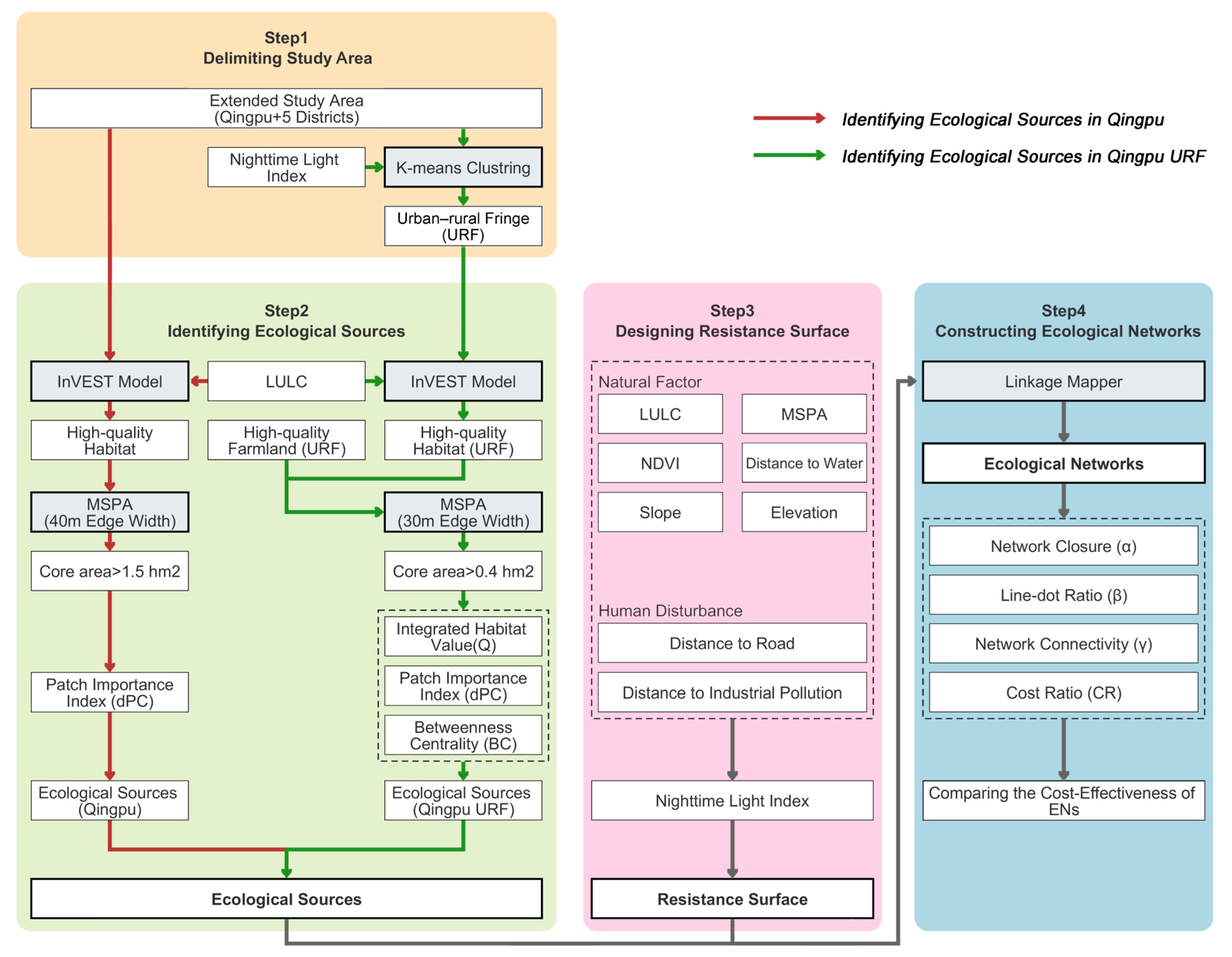
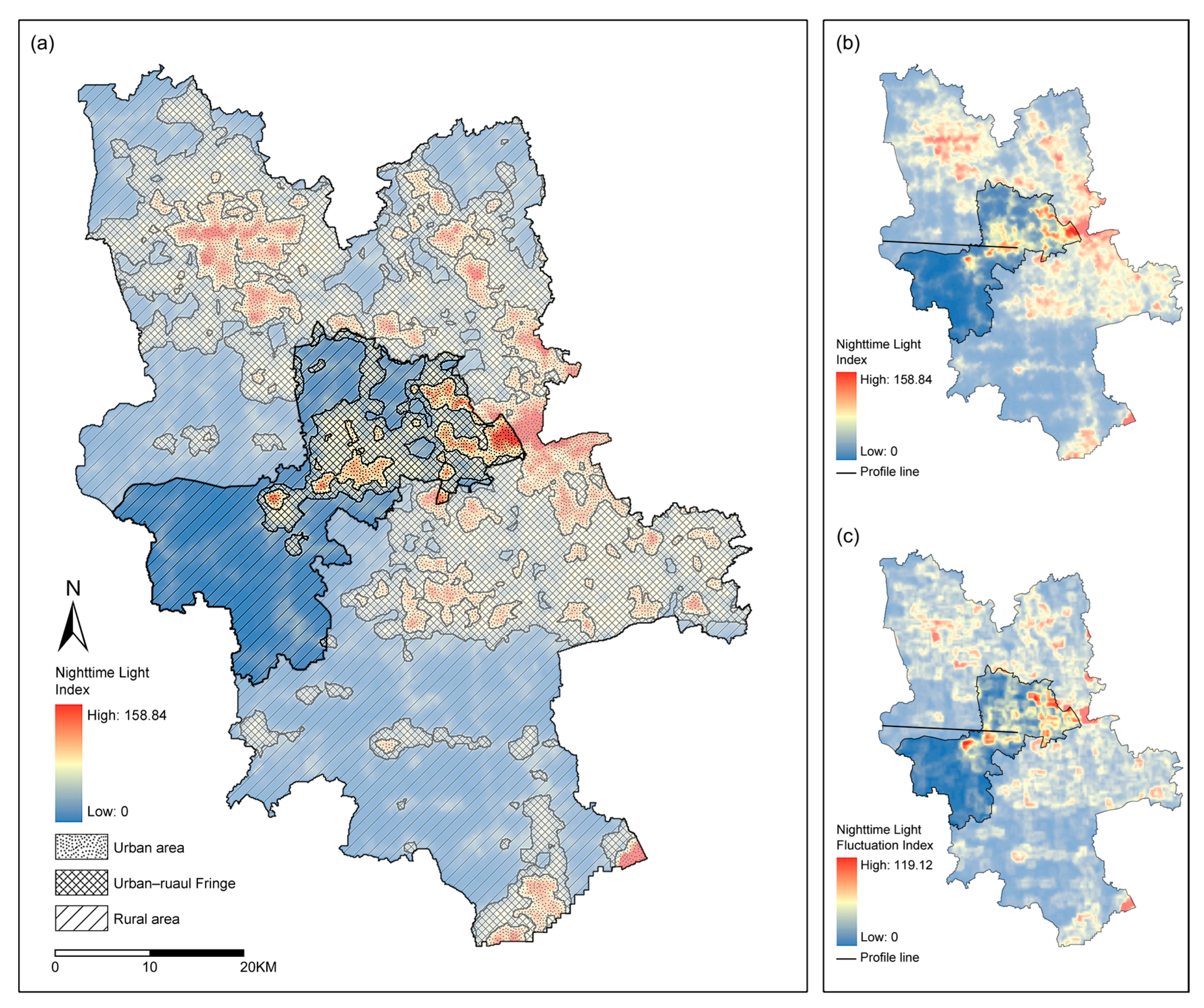
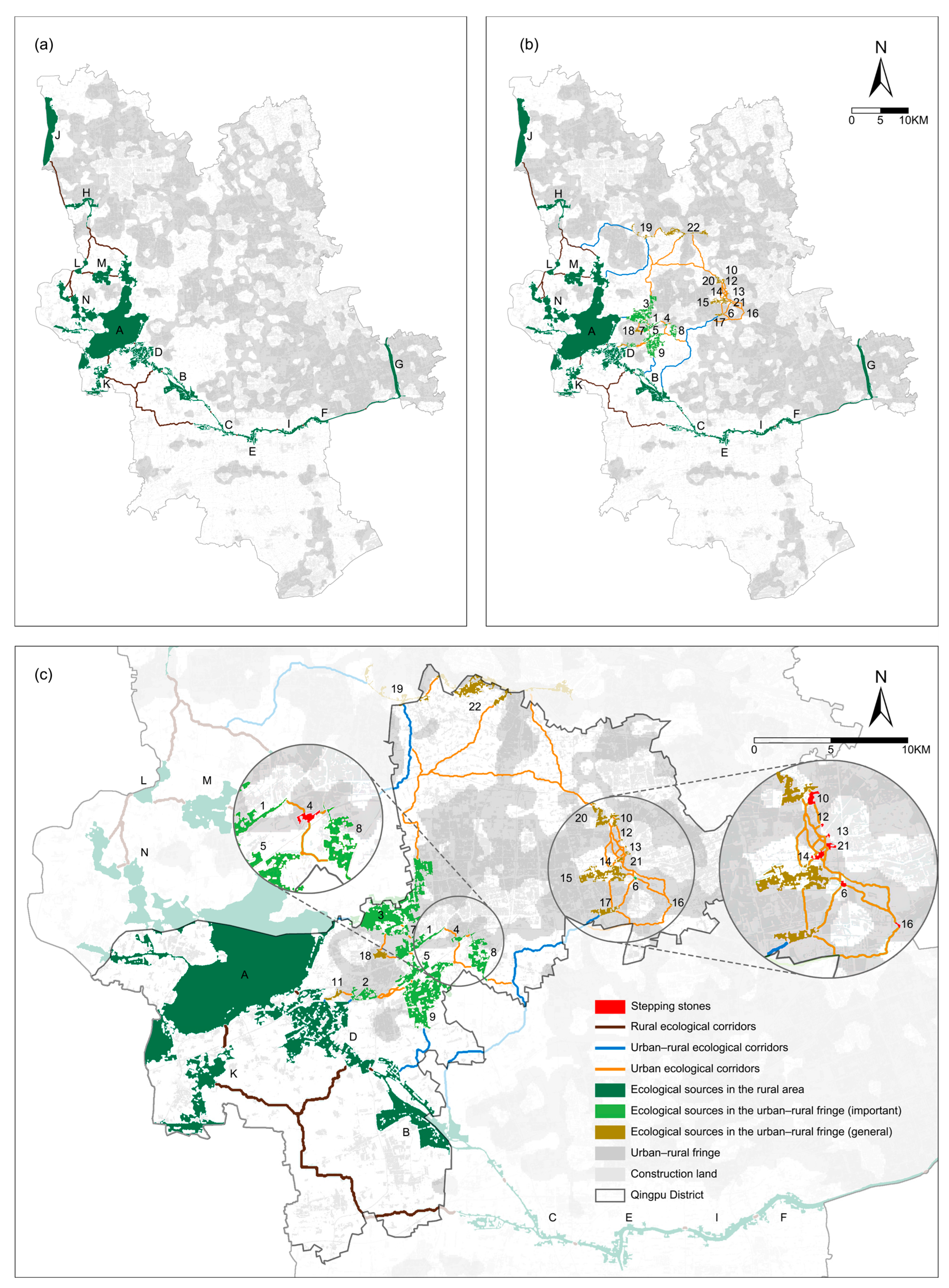

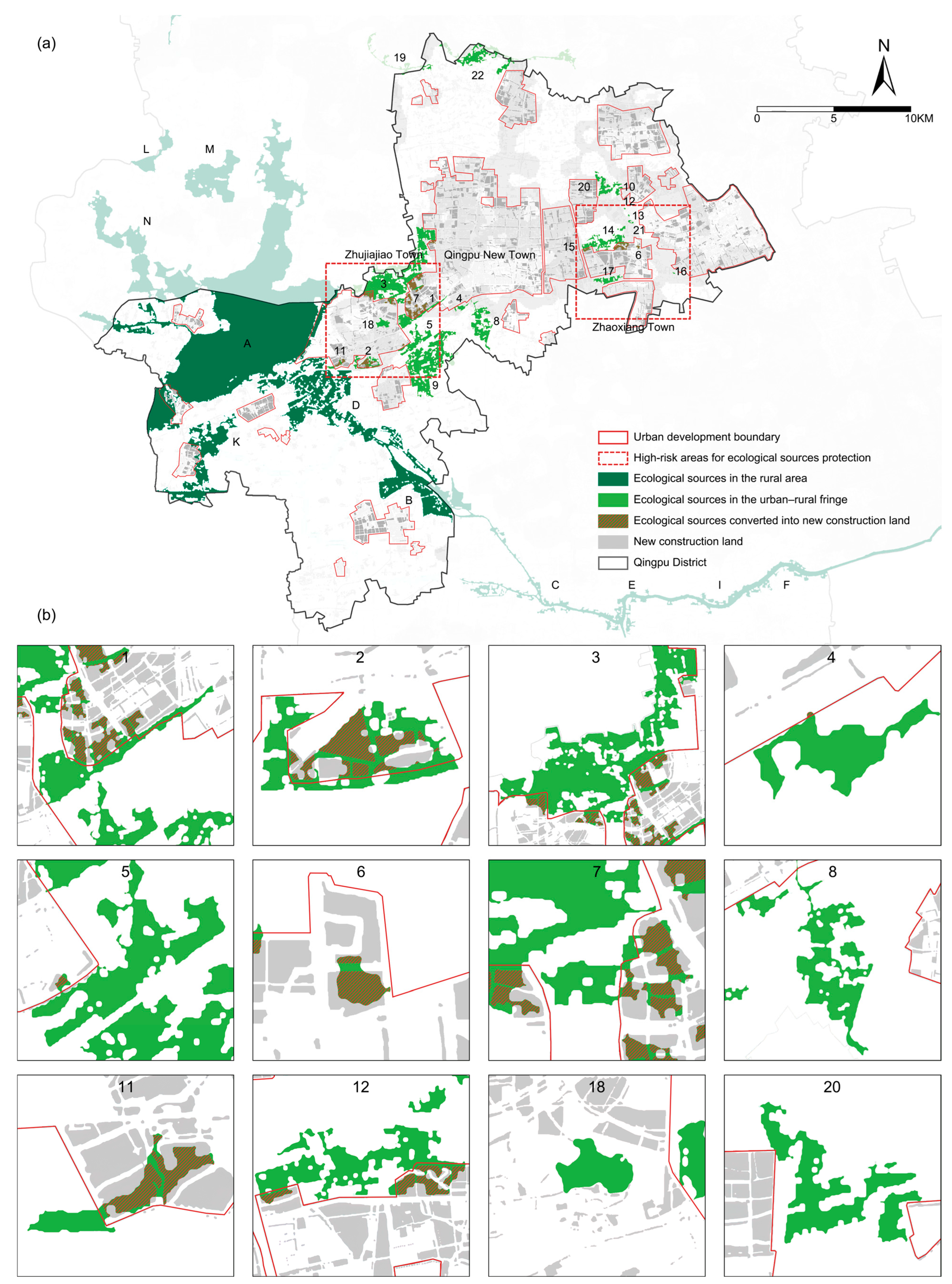
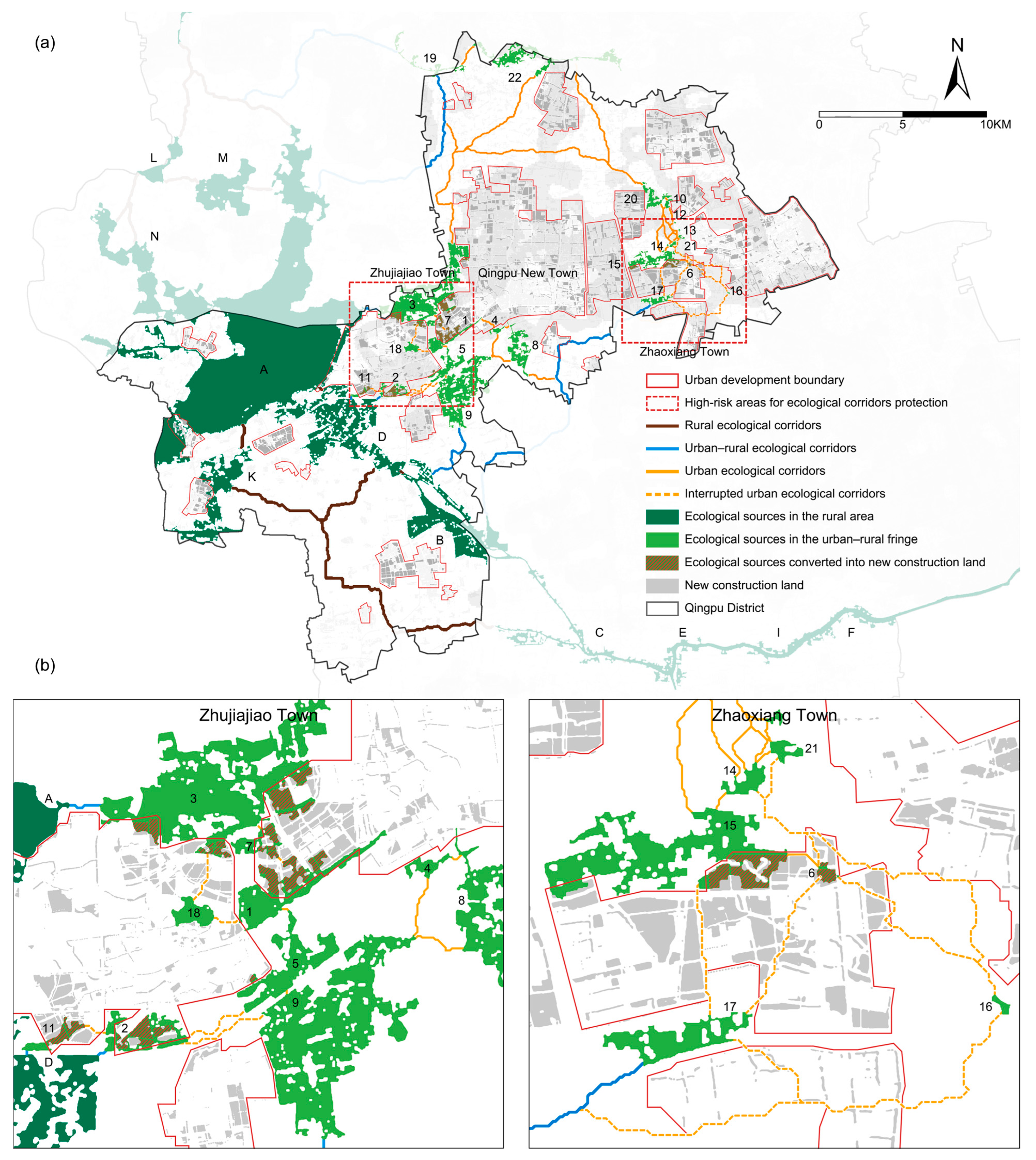
| Threat Factors | Influence Distances/km | Weights | Decay | |
|---|---|---|---|---|
| Road | Expressway | 3 | 1 | Linear |
| Main road | 1 | 0.7 | Linear | |
| Secondary main road | 0.5 | 0.3 | Linear | |
| Construction land | Industrial land | 10 | 0.8 | Exponential |
| Residential land | 5 | 0.6 | Exponential | |
| Other construction land | 3 | 0.5 | Exponential | |
| Land Use/Land Cover | Habitat Suitability | Threat Factors | |||||
|---|---|---|---|---|---|---|---|
| Road | Construction Land | ||||||
| Expressway | Main Road | Secondary Main Road | Industrial Land | Residential Land | Other Construction Land | ||
| Forest | 1 | 0.5 | 0.3 | 0.1 | 1 | 0.2 | 0.2 |
| Bush | 0.7 | 0.6 | 0.5 | 0.3 | 1 | 0.2 | 0.2 |
| Grass | 0.5 | 0.8 | 0.7 | 0.5 | 1 | 0.2 | 0.2 |
| Paddy field | 0.6 | 0.6 | 0.5 | 0.1 | 1 | 0.2 | 0.1 |
| Dry land | 0.3 | 0.3 | 0.2 | 0.1 | 1 | 0.2 | 0.1 |
| River | 0.8 | 0.5 | 0.3 | 0.2 | 0.9 | 0.5 | 0.3 |
| Lake | 1 | 0.4 | 0.3 | 0.2 | 0.9 | 0.5 | 0.3 |
| Pond | 0.7 | 0.4 | 0.3 | 0.2 | 0.8 | 0.5 | 0.3 |
| Wetland | 0.9 | 0.6 | 0.4 | 0.3 | 0.9 | 0.5 | 0.3 |
| Other Construction land | 0 | 0 | 0 | 0 | 0 | 0 | 0 |
| Bare land | 0.1 | 0 | 0 | 0 | 0.3 | 0 | 0 |
| Resistance Factors | Classification | Resistance Values | Weights |
|---|---|---|---|
| Land Use/Land Cover | Forest | 1 | 0.25 |
| Wetland | 1 | ||
| River | 10 | ||
| Lake | 10 | ||
| Pond | 20 | ||
| Bush | 40 | ||
| Grass | 50 | ||
| Paddy field | 50 | ||
| Dry land | 70 | ||
| Bare land | 90 | ||
| Construction land | 100 | ||
| MSPA landscape types | Core | 5 | 0.15 |
| Bridge | 10 | ||
| Loop | 20 | ||
| Branch | 30 | ||
| Islet | 50 | ||
| Edge | 60 | ||
| Perforation | 70 | ||
| Normalized Difference Vegetation Index | >0.7 | 1 | 0.10 |
| 0.5–0.7 | 20 | ||
| 0.3–0.5 | 60 | ||
| 0.1–0.3 | 80 | ||
| <0.1 | 100 | ||
| Distances to water | 0–50 m | 1 | 0.10 |
| 50–300 m | 30 | ||
| 300–500 m | 60 | ||
| >500 m | 100 | ||
| Slope | <8° | 1 | 0.05 |
| 8–15° | 25 | ||
| 15–20 | 50 | ||
| 25–35° | 75 | ||
| >35° | 100 | ||
| Elevation | 0–20 m | 1 | 0.05 |
| 20–40 m | 20 | ||
| 40–60 m | 30 | ||
| 60–80 m | 40 | ||
| >80 m | 50 | ||
| Distances to expressways | >2000 m | 1 | 0.10 |
| 1600–2000 m | 20 | ||
| 1200–1600 m | 40 | ||
| 800–1200 m | 60 | ||
| 400–800 m | 80 | ||
| 0–400 m | 100 | ||
| Distances to main roads | >1000 m | 1 | |
| 800–1000 m | 20 | ||
| 600–800 m | 40 | ||
| 400–600 m | 60 | ||
| 200–400 m | 80 | ||
| 0–200 m | 100 | ||
| Distances to secondary main roads | >400 m | 1 | |
| 300–400 m | 25 | ||
| 200–300 m | 50 | ||
| 100–200 m | 75 | ||
| 0–100 m | 100 | ||
| Distances to industrial pollution | >1500 m | 1 | 0.10 |
| 1000–1500 m | 25 | ||
| 500–1000 m | 50 | ||
| 100–500 m | 75 | ||
| <100 m | 100 |
| Indexes | Formulas | Meanings |
|---|---|---|
| α | The α index calculates the ratio of the actual number of loops to the maximum possible number of loops within the EN, characterizing the degree to which loops are present for species dispersal. | |
| β | The β index calculates the ratio of the number of corridors to the number of source locations in the EN, measuring the network’s connectivity. | |
| γ | The γ index calculates the ratio of the number of corridors to the maximum possible number of corridors within the EN, assessing the connectivity of source locations. | |
| CR | The CR index describes the cost of corridor construction within the EN. |
| Source Types | Source Numbers | Area (hm2) | Q | dPC (%) | BC | Q Scores | dPC Scores | BC Scores | Summed Scores |
|---|---|---|---|---|---|---|---|---|---|
| Important sources | 1 | 131.27 | 1.56 | 8.02 | 0.037 | 5 | 5 | 5 | 15 |
| 2 | 66.04 | 1.06 | 4.69 | 0.022 | 4 | 5 | 4 | 13 | |
| 3 | 669.97 | 0.63 | 7.00 | 0.026 | 2 | 5 | 4 | 11 | |
| 4 | 16.87 | 0.52 | 3.62 | 0.031 | 2 | 5 | 4 | 11 | |
| 5 | 101.90 | 0.96 | 2.59 | 0.022 | 3 | 4 | 4 | 11 | |
| 6 | 4.43 | 1.07 | 0.00 | 0.035 | 4 | 1 | 5 | 10 | |
| 7 | 28.39 | 1.17 | 0.82 | 0.012 | 4 | 3 | 3 | 10 | |
| 8 | 144.89 | 0.65 | 2.06 | 0.023 | 2 | 4 | 4 | 10 | |
| 9 | 492.43 | 0.42 | 4.65 | 0.014 | 2 | 5 | 3 | 10 | |
| General sources | 10 | 13.67 | 0.99 | 0.02 | 0.038 | 3 | 1 | 5 | 9 |
| 11 | 21.47 | 1.59 | 0.37 | 0.001 | 5 | 3 | 1 | 9 | |
| 12 | 0.67 | 0.57 | 0.00 | 0.040 | 2 | 1 | 5 | 8 | |
| 13 | 1.49 | 0.56 | 0.03 | 0.055 | 2 | 1 | 5 | 8 | |
| 14 | 9.50 | 0.64 | 0.03 | 0.056 | 2 | 1 | 5 | 8 | |
| 15 | 132.59 | 0.53 | 0.06 | 0.041 | 2 | 1 | 5 | 8 | |
| 16 | 1.98 | 0.37 | 0.02 | 0.038 | 2 | 1 | 5 | 8 | |
| 17 | 40.85 | 1.17 | 0.01 | 0.015 | 4 | 1 | 3 | 8 | |
| 18 | 32.87 | 2.30 | 0.13 | 0.001 | 5 | 2 | 1 | 8 | |
| 19 | 76.55 | 1.40 | 0.02 | 0.000 | 5 | 1 | 1 | 7 | |
| 20 | 65.98 | 0.11 | 0.06 | 0.050 | 1 | 1 | 5 | 7 | |
| 21 | 5.49 | 0.20 | 0.03 | 0.056 | 1 | 1 | 5 | 7 | |
| 22 | 267.15 | 1.06 | 0.08 | 0.002 | 4 | 1 | 1 | 6 |
| Indicator | Initial EN | Optimized EN | Change Value |
|---|---|---|---|
| L | 18 | 68 | +50 |
| V | 14 | 36 | +22 |
| C | 80.62 | 278.76 | +198.14 |
| α | 0.217 | 0.493 | +0.276 |
| β | 1.285 | 1.889 | +0.604 |
| γ | 0.500 | 0.667 | +0.167 |
| CR | 0.826 | 0.756 | −0.070 |
Disclaimer/Publisher’s Note: The statements, opinions and data contained in all publications are solely those of the individual author(s) and contributor(s) and not of MDPI and/or the editor(s). MDPI and/or the editor(s) disclaim responsibility for any injury to people or property resulting from any ideas, methods, instructions or products referred to in the content. |
© 2024 by the authors. Licensee MDPI, Basel, Switzerland. This article is an open access article distributed under the terms and conditions of the Creative Commons Attribution (CC BY) license (https://creativecommons.org/licenses/by/4.0/).
Share and Cite
Xie, Y.; Ying, J.; Zou, J.; Li, R.; Zhang, H.; Shi, Q.; Li, Y. Habitat Protection in Urban–Rural Fringes through Coordinated Ecological Network Construction and Territorial Planning. Land 2024, 13, 935. https://doi.org/10.3390/land13070935
Xie Y, Ying J, Zou J, Li R, Zhang H, Shi Q, Li Y. Habitat Protection in Urban–Rural Fringes through Coordinated Ecological Network Construction and Territorial Planning. Land. 2024; 13(7):935. https://doi.org/10.3390/land13070935
Chicago/Turabian StyleXie, Yuting, Jiaxin Ying, Jie Zou, Ruohao Li, Haoxun Zhang, Qie Shi, and Yonghua Li. 2024. "Habitat Protection in Urban–Rural Fringes through Coordinated Ecological Network Construction and Territorial Planning" Land 13, no. 7: 935. https://doi.org/10.3390/land13070935
APA StyleXie, Y., Ying, J., Zou, J., Li, R., Zhang, H., Shi, Q., & Li, Y. (2024). Habitat Protection in Urban–Rural Fringes through Coordinated Ecological Network Construction and Territorial Planning. Land, 13(7), 935. https://doi.org/10.3390/land13070935





